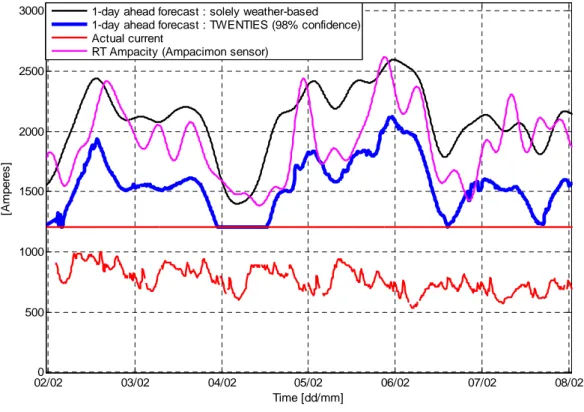NAME : Lilien jean-louis
COUNTRY : BELGIUM
REGISTRATION NUMBER : 341
GROUP REF. : B2
PREF. SUBJECT : 1.3
QUESTION N° : 1.6
1
To the question 1.6 asked by the special reporter « Is among experts information available to on whether actual measurements verify the validity of the ground roughness model ? »
Contribution prepared by Prof. JL Lilien (University of Liège), Huu-Minh Nguyen (PhD student) and Peter Schell (Ampacimon SA). Contact at lilien@montefiore.ulg.ac.be
Ampacity of power lines may actually be deduced in real time using a mature technology with DLR sensors, as detailed in a very recent CIGRE brochure N° 498 (June 2012).
More recent developments are available in ampacity forecasting, using one and two days ahead meteorological tools similar to the one described in the report B2-105 and 106.
Obviously errors in forecasting need to be included in these approaches, which has been done in a running project in Belgium and Spain inside European FP7, called “TWENTIES”.
It is very difficult, some would say nearly impossible to verify the validity of the ground roughness effects without direct (i.e. on the line) DLR measurement systems. These effects are very local but ampacity is more linked to sag (or clearance) which is a global “per span” value. Local spot measurements, like conductor surface temperature and/or weather stations, are not representative of such a “per span” value and cannot be extrapolated easily to obtain a certified clearance value. Indeed temperature changes in longitudinal (on the same span), radial (see report B2-108 with more than 10°C between conductor core and surface at static rating loads around current density close to 2 A/mm2) and even circumferential directions show how variable & local the effects are and cannot in our opinion be used for safe operation in full confidence for the operator. Despite very optimistic presentation in the B2-106 report, it is not looking at temperatures close to the static rating, thus their conclusions on the precision of their temperature evaluation cannot be accepted. Moreover temperature evaluation is of no hope to certify clearances as most recent “lidar” survey on existing lines show large discrepancies between “as design” and “as build” temperature-sag relationships.
Now, real time measurements and forecast values are different matters. Forecast values need a weather forecast if longer than about 4 hours and this is certainly true for one day ahead forecasting.
To extrapolate ampacity from a simple weather forecast makes very little sense because errors in weather forecast may be dramatic, especially for low wind-speed events which are the most interesting cases for ampacity limits. Our return of experience on about 2 years observations using weather forecast and permanent direct monitoring (Fig1) shows:
- Real time observation helps to progressively build (in a few months, typically 3) a database of occurrences of discrepancies between actual ampacity (obviously only made available with direct systems) and ampacity forecasted based on weather forecasts deduced by the best prediction tools available on the market comparable to those described in B2-105 and 106 papers.
- Doing that permanently, a forecasted ampacity can be generated with a determined error (e.g. never exceed the real-time rating for 98% of the time) in full confidence.(Fig 2)
- That method has been actually implemented in CORESO to supervise some lines inside CWE (central Western Europe), for day-ahead contingencies analysis.
- In parallel with that, stability concerns are also evaluated, if any and actions are prepared one day in advance to solve these congestions
- All of these tools are particularly useful in case of wind farm production, which may affect the whole CWE region for a production in the North Sea or Baltic Sea.
2
Fig 1 : Ampacimon sensor to certify the sag of power lines and evaluate ampacity of power line from real time to two days ahead.
Fig 2. One full week of 24 hours-ahead ampacity forecast compared with real time ampacity and weather based forecast ampacity (Courtesy Ampacimon SA).
Conclusion :
We would like to suggest TSOs to use a broad approach to DLR, where the best possible weather forecasts are used together with the most reliable real-time measurement techniques. In our experience this approach can give a margin of extra power of 25% above seasonal ratings most of the time with a limited initial overview of the line and making some low cost actions.
Temperature sensor and weather stations used in B2-105 are a good tool to assess the global gain, but they are not recommended for certification of the actual power line behavior in operation (security, market), which may be very far from the “as design” state.
Direct DLR sensors may nowadays be used with full confidence to provide ampacity. Forecasting tools are also available for up to 2 days ahead with some actors of DLR.
Ampacimon devices and software is one of these solutions.
02/020 03/02 04/02 05/02 06/02 07/02 08/02 500 1000 1500 2000 2500 3000 Time [dd/mm] [A m p e re s ]
1-day ahead forecast : solely weather-based 1-day ahead forecast : TWENTIES (98% confidence) Actual current
